Filming on location
From the very earliest days, the railroad has been an essential element of motion pictures and television.
Trains powerfully establish specific times and places, or more generally suggest “the past” to viewers of all ages and backgrounds. The locomotive is an icon in American culture and a symbol of progress and industrial might. The railroad is so much a part of American life that the question often is not whether to use a train, but how to accomplish it. The California State Railroad Museum, its Foundation, and its related organizations, such as the Sacramento Southern Railroad and the Sierra Railroad Company, will help make the railroad an integral part of your production – and do so in an efficient, economical, and historically accurate fashion. The Museum is committed to cooperation with the motion picture and television industries as an important part of its mission to “tell the story of railroading” to the widest possible audience.
Through its vast facilities, the California State Railroad Museum can help create sets, landscapes, and action representing virtually any part of the country over a 150-year time span. And it can make the illusion real with its unparalleled collections of railroad equipment and artifacts. Nowhere else in the United States does one organization offer:
- Range of scenery and location possibilities
- Variety of trains, buildings, and props
- Ease of access
- Full complement of support services
- Depth of research resources
- Willingness to make things happen efficiently, economically, and with a minimum of red tape.
The California State Railroad Museum is a part of California State Parks. The Museum encompasses a wide variety of facilities at two sites: the California State Railroad Museum complex in Old Sacramento, and the l00-year-old Sierra Railroad Shops at Railtown 1897 in Jamestown, California, 90 miles southeast of Sacramento in the Sierra foothills.
- The Museum of Railroad History, a 100,000-square-foot facility housing an unparalleled collection of locomotives, cars, artifacts, graphics, interpretive exhibits, and location opportunities.
- The Eagle Theatre, a reconstructed performing-arts venue, first established in 1849. This unique canvas and wood-frame structure pays testimony to the transient nature of Sacramento’s first buildings. Today it hosts a wide varitey of live productions, children’s theatre, and school group tours.
- The 1849 Scene, part of the much larger Old Sacramento Historic District. The 1849 Scene carefully recreates a part of Sacramento as it appeared shortly after the Gold Rush, but it can be dressed as everything from a typical Western town of the last century to a colonial outpost.
- The Central Pacific Railroad Passenger Station, a replica of the 1860s wood structure that handled the railroad’s passenger and express business for decades. Adjacent to the Passenger Depot is the replica Central Pacific Railroad Freight Depot. The area has additional nineteenth-century buildings and wharves, and the Sacramento River itself.
- The Sacramento Southern Railroad, the Museum’s historic railroad. Several miles of track are available for use, along with steam and diesel locomotives from many eras and railroads. The scenery ranges from industrial/urban to wooded/rural/riverside. At the south end of the Sacramento Southern Railroad is a wildlife refuge. To the west of the railroad the vista is of central California farmland; to the east, the vista is of trees, water, vegetation, and wilderness. The countryside resembles areas ranging from Chesapeake/Atlantic tidewater to Florida Everglades to the Ohio-Mississippi River system. This is an exceedingly versatile line of railroad and could represent hundreds of remote locations throughout the country – especially for historical periods. The presence of the railroad alongside the waterway also would permit extended pan-dolly/following shots of action taking place on the water.
- The California State Railroad Museum Library is the nation’s largest and most comprehensive railroad research facility, with over one million graphic images, books, corporate archives, and research materials covering the entire United States. The Library is an excellent resource for writers, art directors, set designers, and anyone working to establish historic details
Selected Credits
Let Us Help You!
The California State Railroad Museum is able to provide locations and equipment for every railroad situation. With creativity and the historic assets at CSRM just about everything is possible. Plus, the Museum’s staff can advise not only as to what was historically correct, but also as to what will be “good enough” to represent a desired period and situation in a convincing fashion. The Museum recognizes the commercial realities of dramatic representation, and works with clients to find practical, affordable, plausible solutions to their needs.
The California State Railroad Museum looks forward to your inquiry, and will do its best to make railroading a part of your picture. For filming inquiries, please contact Francesca Martella at (916) 893-3534 or [email protected]. For all other media inquiries, please contact Dr. Ty Smith at [email protected].
For more information about filming in California State Parks please click here.
For details about filming throughout Sacramento County, visit the Sacramento Convention & Visitors Bureau’s “filmmakers” page at their website.

